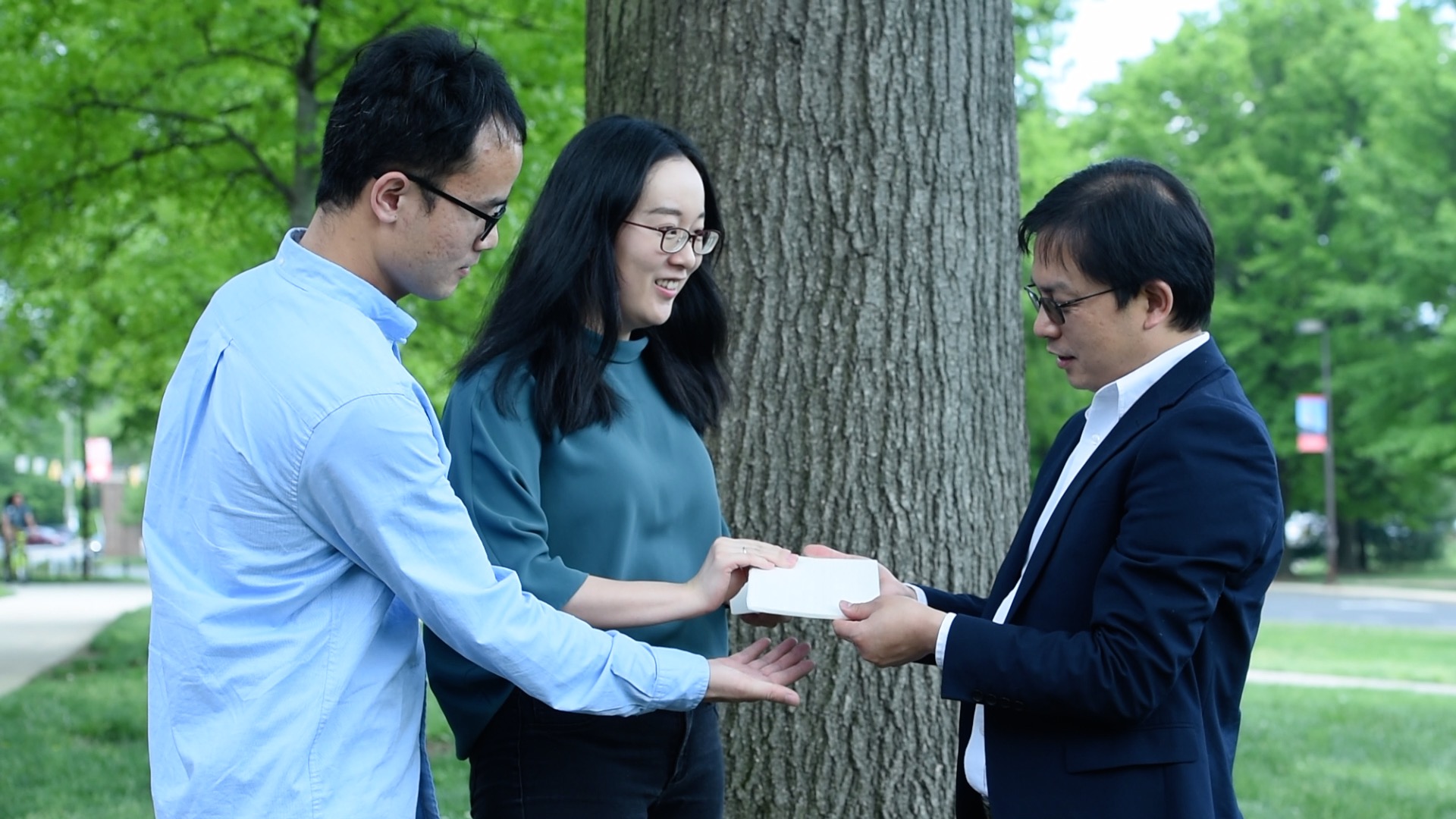
|
 |
Dr. Liangbing Hu (L) and team members Dr. Tian Li (C) and Dr. Shuaiming He (R) stand in front of the natural inspiration for their new heat-shedding Cooling Wood. |
|
COLLEGE PARK -- What if the wood your house was made of could save your electricity bill? In the race to save energy, using a passive cooling method that requires no electricity and is built right into your house could save even chilly areas of the US some cash. Now, researchers at the University of Maryland and the University of Colorado have harnessed nature’s nanotechnology to help solve the problem of finding a passive way for buildings to dump heat that is sustainable and strong.
Wood solves the problem – it is already used as a building material, and is renewable and sustainable. Using tiny structures found in wood – cellulose nanofibers and the natural chambers that grow to pass water and nutrients up and down inside a living tree - that specially processed wood has optical properties that radiate heat away. The results of this study were published May 9 in the journal Science.
“This work has greatly extended the use of wood towards high performance energy efficient applications and provided a sustainable route to combat the energy crisis,” said Northeast Forestry University Professor Jian Li, a member of Chinese Academy of Engineering, who is not associated with the research.
At the University of Maryland, Liangbing Hu, co-first authors Tian Li and Shuaiming He and others in the department of materials science have been working with wood for many years. Hu’s team has invented a range of emerging wood nanotechnologies, including a transparent wood, low cost wood batteries, super strong wood, super thermal insulating wood, and a wood-based water purifier.
“This is another major advancement in wood nanotechnologies that Hu group at University of Maryland achieved: cooling wood that is made of solely wood -- that is, no any other component such as polymers -- can cool your house as a green building material,” said Dr. Hu.
WATCH: Researchers make really cool wood for energy efficiency https://go.umd.edu/coolwood
The team at Boulder, led by Prof. Xiaobo Yin and Prof. Ronggui Yang, both of the of the department of mechanical engineering and the program of materials science at the University of Colorado in Boulder, have been working on materials for radiative cooling, including thin films and paints.
“When applied to building, this game-changing structural material cools without the input of electricity or water,” said Dr. Yao Zhai, co-first author from the Boulder team.
By removing the lignin, the part of the wood that makes it brown and strong, the UMD researchers created a very pale wood made of cellulose nanofibers. They then compressed the wood to restore its strength. To make it water repellent, they added a super hydrophobic compound that helps protect the wood. The result: a bright white building material that could be used for roofs to push away heat from inside the building.
They took the cooling wood out into the ideal testing condition of a farm in Arizona where the weather is always warm and sunny, with low winds. There, they tested the cooling wood and found that it stayed, on average, five or six degrees F cooler than the ambient air temperature – even at the hottest part of the day, the cooling wood was chillier than air. It stayed on average 12 degrees cooler than natural wood, which warms up more in the presence of sunlight.
“The processed wood uses the cold universe as heat sink and release thermal energy into it via atmospheric transparency window. It is a sustainable material for sustainable energy to combat global warming” said Dr. Li.
The mechanical strength per weight of this wood is also stronger than steel, which makes it a great choice for building materials. It is ten times stronger than natural wood and beats steel’s strength, reaching 334 MPa·cm3/g (compared to 110 MPa·cm3/g for steel). It also damages less easily (scratch test) and can bear more weight (compression test) than natural wood.
Other collaborators include Jelena Srebric’s team at the University of Maryland, College Park; Ronggui Yang’s team at the University of Colorado, Boulder; and Ashlie Martini’s team at the University of California Merced.
To see how much energy the wood saves, they calculated how much heat is used by typical apartment buildings in cities across the US in all climate zones. Hot cities like Phoenix and Honolulu would save the most energy, especially if older buildings had their siding and roofs replaced with cooling wood. Buildings across the US that were built after 2004, or now, would save on average 20% of cooling costs.
"Prof. Hu and collaborators show yet another use of wood that is not only structurally strong but useful as active component for energy management. It is interesting that the same material that releases heat upon combustion can be used for cooling, offering new opportunities in green buildings," said Orlando Rojas, a professor in the department of Bioproducts and Biosystems at Aalto University, Finland.
The research was funded by the University of Maryland.
A company co-founded by Dr. Hu, Inventwood, is focusing on the commercialization of these advanced wood nanotechnologies (www.inventwood.com).
A company co-founded by Dr. Yang and Yin, Radi-Cool, is focusing on the commercialization of the radiative cooling technologies (www.radi-cool.com).
Related Articles:
'Wood' You Like Some Fresh Water?
Wood-based Technology Creates Electricity from Heat
Clark School Seed Grant Awards Announced
MATRIX Lab Hiring Research Development Director
Dutt is PI on NSF-Funded Quantum Research Grant
Maryland Engineers Awarded Grants to Address Humanity's Grand Challenges
Big Ten Network spotlights Maryland Engineering
Selected Publications from NanoCenter's AIM Lab and FabLab
Nine Maryland Engineers Recognized as Being "One in 1,000"
Seven UMD Engineers Recognized as Highly Cited Researchers
May 22, 2019
|